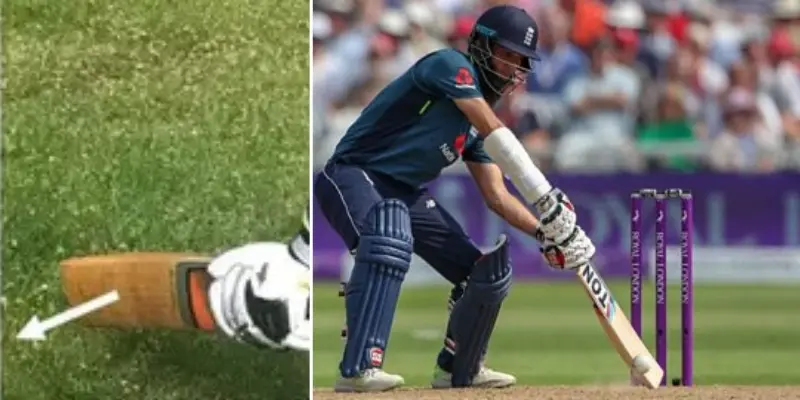Cricket 101 | How to Grip a Cricket Bat for Maximum Control
Published: 1 Jan 2025
The grip on a cricket bat is not just about holding it tight – it’s the foundation of a player’s entire batting technique. It equally influences a budding cricketer or even seasoned pro, how well they play shots, how much control they have over the game, and how effectively they can adapt to various types of deliveries.

Take Sachin Tendulkar, for example. Known for his flawless technique, Tendulkar’s grip allowed him to play both aggressive drives and delicate flicks with precision. Then there’s MS Dhoni, whose unorthodox yet highly effective grip made him one of the most successful finishers in the game. Even Steve Smith, with his unconventional grip, has redefined modern-day batting.
These players show us that while there are traditional ways to hold the bat, personalizing your grip is often the key to success.
In this post, we’ll break down how to grip a cricket bat and how each style can affect your batting.
The Importance of Proper Bat Grip
It’s not just about comfort; it directly influences how well you play control shots and respond to different deliveries. Whether you’re facing a pace bowler or a spinner, how you hold your bat will determine the success of your shot.
Better Control: The right grip helps you control the bat’s movement, allowing you to drive the ball to the desired area of the field.
Improved Shot Play: With the right grip, you’ll be able to play a variety of shots with more consistency – whether it’s a drive, cut, or pull shot.
Comfort and Confidence: A grip that goes with your batting style allows you to feel comfortable and confident. It helps in reducing strain on your hands and arms, which can lead to better performance over longer innings.
V Grip – The Traditional Approach
The V grip is the most traditional and widely used method for holding a cricket bat. It’s often the go-to grip taught to beginners because it offers a great balance of control, comfort, and versatility.
What is the V Grip?
The V grip gets its name from the shape your hands create on the bat’s handle. When you hold the bat with both hands, your index fingers and thumbs form a “V” shape. This grip allows for better alignment and more control over the bat, helping you play a wide variety of shots with precision.
How to Do the V Grip?
Here’s how to get it right:
1-Position Your Hands: Start by holding the handle of the bat with your dominant hand (right hand for right-handed batsmen, left for left-handed) at the bottom and your non-dominant hand at the top.
2-Create the V: Place your thumb and index finger of each hand in a way that they form a “V” shape, with both Vs pointing downward towards the bottom of the bat.
3-Keep Your Hands Apart: Aim to keep a small space (about two fingers’ width) between your hands. This helps in providing more movement and flexibility during shots.
4-Relaxed Grip: It’s crucial not to grip the bat too tightly. A relaxed but firm hold will give you better control while still allowing fluidity when playing shots.
Why is the V Grip Effective?
Control and Precision: The V grip helps you play controlled shots like drives, cuts, and pulls because your hands are aligned with the bat’s spine, making it easier to direct the ball where you want it to go.
Comfortable for Beginners and Pros Alike: Whether you’re a seasoned player or just starting out, this grip is easy to learn and use. Even top players like Sachin Tendulkar and Ricky Ponting used variations of the V grip, which proves its effectiveness at every level of the game.
Versatile for Different Shots: With the V grip, you can play a range of shots. From defensive to attacking, it works well for nearly every type of delivery.
The O Grip – A Stronger Hold for Powerful Shots
The O grip is a slightly different technique compared to the traditional V grip. This grip is ideal for players who prefer more power behind their shots and a more secure and firm hold on the bat.
What is the O Grip?
The O grip, as the name suggests, forms an “O” shape with your hands when you grip the bat. It’s often used by players who enjoy hitting cross-batted shots, like pulls and hooks, as it allows for a stronger and more stable hold on the bat’s handle.
How to Do the O Grip?

Here’s how to get the O grip just right:
1-Start with the V grip: Begin by holding the bat as you would with the traditional V grip, but then make a few adjustments.
2-Create the “O” Shape: To form the “O” shape, wrap your fingers fully around the handle so that your hand is almost completely under the bat. Rotate the handle slightly, with your hands now positioned horizontally to the ground.
3-Adjust Your Hands: Unlike the V grip, the O grip typically requires a slightly lower hand placement, providing a stronger grip when the batter is looking to hit the bowler hard and play big shorts.
Why Use the O Grip?
Powerful Cross-Batted Shots: The O grip is excellent for playing cross-batted shots like hooks, pulls, and slashes. It gives you more stability, which is necessary for these power shots, and it’s particularly useful when hitting deliveries aimed at your body.
Better for Heavy Bats: If you’re using a heavier cricket bat, the O grip might be more comfortable. It gives you better control over the heavier weight, allowing you to generate more power without losing balance or control.
Helps with Stability: The O grip can help add more balance to your shots, as the horizontal hand position allows you to control the bat better, especially when hitting short-pitched deliveries or playing defensive shots.
Who Uses the O Grip?
While not as common as the V grip, the O grip is still popular among professional players who like to play a powerful and controlled swing of the bat. Players who prefer a heavy bat or need more stability for certain shots, such as the likes of Faf du Plessis or David Warner, may adopt the O grip for its added strength and stability.
How to Apply the O Grip
1-Start with the V Grip: Begin by holding the bat using the traditional V grip, with your thumb and forefinger forming a “V” shape.
2-Rotate the Hands: To turn it into an O grip, slightly rotate your top hand counterclockwise (if you’re a right-handed batter) or clockwise (if you’re a left-handed batter). This will position your hands in such a way that your fingers are fully under the handle of the bat, instead of just the tips.
3-Positioning: The O grip essentially forms an “O” shape with your hands, and your top hand will be flat against the bat, making it easier to handle powerful shots, especially when playing cross-batted strokes.
Why Use the O Grip?
Better for Cross-Batted Shots: The O grip provides more wrist action and can be helpful when you’re playing across the line, such as with a pull or hook shot.
Heavier Willow: If you prefer using a heavy bat, the O grip can provide better control, helping you manage the additional weight without losing the ability to strike the ball cleanly.
However, keep in mind that while this grip can be beneficial for certain shots, it may make it harder to play with precision on the off-side. If you’re the type of player who loves driving the ball through the off-side, this may not be the best grip for you.
The Knott Grip: A Technique for Adaptability
The Knott grip is named after the legendary English cricketer Alan Knott, who was known for his exceptional wicket-keeping skills as well as his batting technique. This grip is a bit different from the conventional ones and is often used by players who want to adapt their grip based on the type of delivery they are facing. It’s particularly useful when you need to handle tricky or tough deliveries with precision.
How to Apply the Knott Grip
1-Start with the V Grip: Begin with the standard V grip that is commonly used for general batting.
2-Rotate the Top Hand: The key feature of the Knott grip is that you rotate your top hand (your left hand if you’re a right-handed batter) clockwise, or your bottom hand (right hand for left-handed batters) counterclockwise, depending on your comfort and playing style. This rotation moves your thumb and forefinger in such a way that the “V” opens up wider.
3-Adjust the Hand Placement: When using the Knott grip, the back of your top hand will almost face the same direction as the back of the bottom hand. This gives your hands a more uniform feel while handling the bat and allows you to adjust quickly to different types of deliveries.
Why Use the Knott Grip?
Flexible Batting: This grip provides flexibility by allowing you to adjust your hands based on the type of ball being bowled. Whether it’s a quick delivery or a slower ball, the Knott grip helps you maintain control while adapting your play accordingly.
Great for Tough Balls: It’s particularly useful for batsmen who are facing tricky deliveries, as the grip allows for greater maneuverability when hitting tough balls that other grips might make difficult to control.
While it’s not as widely used as the V grip, the Knott grip gives batsmen an edge when it comes to versatility and adaptability. If you often face fast bowlers or deliveries that are difficult to judge, giving the Knott grip a try may be worth your while.
The Open Face Grip: A Clever Way to Tackle Challenging Deliveries
The open face grip is a somewhat unconventional method, but it can be extremely effective when used correctly. It’s not as commonly seen in regular play, but it has proven to be a valuable technique for batters when they need to be creative and looking for improvisation in their game. A good example of a player who uses the open face grip is England’s Jos Buttler, who uses it to play against yorkers and hit the ball to the off-side.
How to Apply the Open Face Grip

Start with the V Grip: As with other grips, you begin by holding the bat in the standard V grip.
Rotate the Handle: To transform the V grip into an open face grip, rotate the handle slightly during the bowler’s delivery. For right-handed batters, this means slightly turning the handle counterclockwise, while left-handed batters will rotate it clockwise.
Expose the Face: The key feature of the open face grip is that the face of the bat should be exposed toward the off-side. This helps in playing shots to the off-side, making it easier to hit balls that are challenging to reach with a conventional vertical bat.
Why Use the Open Face Grip?
Great for Playing Yorkers: One of the main advantages of the open face grip is its ability to play yorkers. Yorkers are difficult to play with a vertical bat, but the open face grip allows you to angle the bat and drive the ball past the fielders.
Increased Flexibility: This grip gives batsmen more flexibility to reach balls that might otherwise be missed with a standard grip. It can be especially useful when trying to play an off-drive or cutting the ball to the off-side.
Creative Shot Making: The open face grip is a useful tool for batsmen who enjoy playing inventive, unorthodox shots. It’s a great way to add more variety to your play, especially when facing deliveries in tight situations.
When Not to Use the Open Face Grip
- Avoid for Leg-Side Deliveries: The open face grip makes it more difficult to play deliveries on the leg side, so it should only be used when you’re looking to play shots to the off-side. Overuse of this grip can limit your ability to play well-rounded shots.
Grip Variation for Different Deliveries: Adapting to the Bowlers
In cricket, the ability to adapt your grip to different types of deliveries can make a huge difference in how effectively you can play. Top batsmen often vary their grip based on the bowler’s pace, spin, and the line or length of the delivery. By adjusting your grip, you can gain more control and improve your batting skills, especially against challenging deliveries like bouncers, yorkers, or spinning balls.
Adjusting Grip for Fast Bowlers
When fast bowlers are in action, it’s crucial to maintain a firm grip on the bat to counter the pace and power of the ball. A slightly firm grip gives better control and stability for driving or defending the fast bowling.
- For Fast Deliveries:
- Firm Grip: Keep a firm grip with both hands. This will help absorb the shock and give you the control needed for solid defensive shots or aggressive drives.
- Low Hands: (Aka using a short handle) Lower your hands slightly toward the bottom of the bat to gain better control of the bat’s sweet spot, especially for lower deliveries.
Adjusting Grip for Spinners
Against spin bowling the batter requires a more relaxed and subtle grip to allow for better bat control and to play more delicate and creative shots. A relaxed grip helps you judge and play the turn of the ball more effectively.
- For Spin Deliveries:
- Relaxed Grip: Use a more relaxed grip, especially with the top hand, so you can feel the ball better and play with more finesse.
- Top Hand Control: Maintain stronger control with the top hand to direct the ball more precisely. You may also need to adjust your grip depending on the type of spin (off-spin or leg-spin).
Adjusting for Yorkers
Yorkers can be tricky to deal with, but by altering your grip, you can play them more effectively. The key is to get under the ball to drive or defend it properly.
- For Yorkers:
- Firm Grip: You’ll need a firmer grip to get the bat down in time. A relaxed grip might result in mis-hits.
- Angle the Bat: Make sure the bat’s face is angled slightly downwards as you meet the ball. This will help in playing a controlled shot.
Adjusting for Bouncers
When facing bouncers, especially on fast pitches, you need a grip that allows you to be flexible and respond quickly. The goal here is to keep your hands comfortable while also ready to play the shot quickly.
- For Bouncers:
- Loose Top Hand: Keep a loose top hand to allow for quick reactions. This will help you hook, pull, or cut the ball comfortably.
- Firm Bottom Hand: Your bottom hand needs to be firm to control the bat and execute the shot under pressure.
Why is Grip Variation Important?
- More Control: Adjusting your grip gives you more control over how you face different types of deliveries. Whether it’s a bouncer, a yorker, or a spin ball, being able to adapt your grip ensures you can play the ball effectively.
- Better Shot Execution: By modifying your grip based on the ball’s line, length, and pace, you increase your chances of making solid contact and executing successful shots.
- Increased Flexibility: The more adaptable your grip, the better your ability to play all types of cricket shots—whether it’s a powerful cover drive, a delicate cut, or a defensive block.
The Balance Between Comfort and Personalization
Every player is unique. Experiment with hand placement and grip styles to find what suits your batting technique. Your grip on the bat should feel natural and comfortable. A relaxed grip prevents muscle fatigue and enhances flexibility, helping you respond swiftly to deliveries. While conventional grips like the V Grip or O Grip are recommended,
Maintaining your bat grip is also crucial—ensure it’s not slippery or worn out. Choose a grip thickness and material that complements your playing style, whether aggressive or defensive. Comfort and personalization are key to better control and consistency at the crease.

- Be Respectful
- Stay Relevant
- Stay Positive
- True Feedback
- Encourage Discussion
- Avoid Spamming
- No Fake News
- Don't Copy-Paste
- No Personal Attacks

- Be Respectful
- Stay Relevant
- Stay Positive
- True Feedback
- Encourage Discussion
- Avoid Spamming
- No Fake News
- Don't Copy-Paste
- No Personal Attacks






